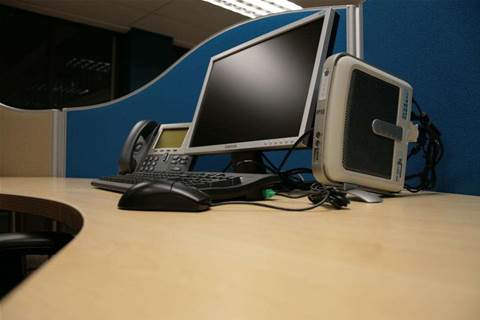Dr McIsaac cautions resellers not to be bound up in the hype around virtual desktops; IBRS research shows less than one percent of desktops are virtualised and that won't change swiftly.
"The key piece of advice I would give anyone in the channel is the market hype is very high on this product," Dr McIsaac says.
"What is often believed to be the case of high adoption, very successful, large-scale replacement of desktops is not accurate. Virtual desktops have a place but largely it's in very specific niche cases."
What may give virtual desktops a boot in the backside is customers' thirst to upgrade to Windows 7.
Such "forklift upgrades", where whole systems and standard operating environments are replaced are an excellent time to do the virtual desktop legwork, says Jocelyn Goldfein, vice president and general manager of the desktop business unit at virtualisation software maker, VMware.
"For someone upgrading to Windows 7 this is an excellent time because you have to think hardware [and] desktop applications," Goldfein says.
"Unusually, this is a situation where you can do them together.
"Once you are virtualised, it becomes very easy to delete old applications or add new applications and operating systems and it becomes very easy to roll back. Rather than roll out Windows XP one day and Windows 7 the next you can roll it out in a more organic approach.
"It makes it incremental rather than a massive revolution."
VMware Asia-Pacific product marketing manager David Wakeman says resellers offering hosted services should look at virtual offices created in minutes using wizard interfaces to cobble together such services as Exchange e-mail, servers and desktops.
Some big telecommunications companies and infrastructure providers such as Melbourne IT, Webcentral, IBM and Fujitsu are already moving this way.
"Long-term, the wave is to make it an externally hosted offering," Wakeman says. "The short-term opportunity is to take on managed desktops for the customer."
Sydney's Virtual.Offis has 40 resellers and its own corporate user customers providing such a service.
Virtual.Offis founder Craig Allen says the company rents products from Microsoft for its customers
by the hour.
"A key driver we saw is this is a secure, easy and fast way for provisioning billable IT services," Allen says. "A lot of products don't allow you to do billing for that service.
"In the physical world someone may have Visio installed on a workstation and someone else wants to use that application so they have to physically use that workstation - but I can make that available to all [under a licence agreement with Microsoft]."
Allen says virtualised desktops suffer from Australia's tyranny of bandwidth; Australian ISPs are among the most expensive in the world for the purposes of virtualisation.
"We live in the dark ages here; there's only two countries in the world that charge for excess bandwidth and do throttling," Allen says. "The US has been 10-times more cost effective than here."
Financial organisations are especially attracted to virtual desktops. Allen says they benefit from a prudential point of view but IBRS' Dr McIsaac says it's mostly a cost-risk analysis.
"Security is amazing; trying to do compliance with workstations is next to impossible," Allen says. "Everyone has a USB port or CD-ROM burner and there's no way to track where that data goes, but with a virtual desktop solution I can lock it down completely."
Banks have used virtual desktops to provide environments to their offshore developers, Dr McIsaac says: "They have application development of code they consider to be quite valuable - they want to keep it onshore for control - it's a quick way to give a preconfigured desktop to someone in another country."
Allen says he started Virtual.Offis with the goal of a stateless device - no need for storage, memory or processor. US hardware developer, Pano Logic, is a startup providing something very close to that concept.
It has hardware and management software to help businesses virtualise their work forces. Pano Logic calls its paperweight-sized Pano Device a "zero client", configured through associated management software and a Windows wizard installer.
Pano Logic product vice president Mike Fodor says it has a niche in challenged environments and where privacy, identity and security management are paramount, such as hospitals, factories and hospitality.
"There's never any local data resident on the device," Fodor says. "For customers in healthcare, banking and education an appealing factor is there's no liability - if someone walked off with a Pano Device there's no chance there's any sensitive patient information on there."
Pano Logic's Australian distributor Virtual Desktops Australia finds the devices ideal for environments that use Windows XP and need multimedia, says director Adam Lawton.
But the heaviness of the packets sent with Pano Logic's proprietary protocol count them out for use in a remote data centre, Lawton says.
"The product is limited to Windows XP; it's well suited to call centres, task workers where you have a common set of roles that a group of individuals perform in a LAN environment [but it's] not targeted at the data centre," Lawton says.
The CRN view
Virtual desktops shouldn't be sold on the basis of cost because the evidence is flimsy that there are savings over well-managed desktops. They should be sold on a case-by-case basis depending on the operational needs of the customer. For instance, customers concerned their data or intellectual property could fall into the wrong hands may be better suited to virtual desktops especially if their workers are more task oriented. Customers with virtualised servers are the low-hanging fruit for virtual desktops and may more readily accept virtual desktops for some of their workers.












.jpg&w=100&c=1&s=0)
_(8).jpg&w=100&c=1&s=0)








.jpg&q=95&h=298&w=480&c=1&s=1)


